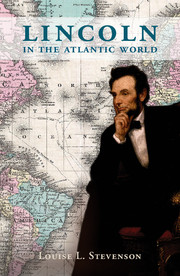Book contents
- Frontmatter
- Dedication
- Contents
- Acknowledgments
- Introduction: My Lincoln Lessons
- 1 The Second Shot Heard ’Round the World
- 2 African Lessons
- 3 European Lessons
- 4 German Lessons
- 5 English Lessons
- 6 Lessons from International Law
- 7 German Lessons for Reelection
- 8 The Last Lesson
- Notes
- Selected Bibliography
- Index
5 - English Lessons
Published online by Cambridge University Press: 05 November 2015
- Frontmatter
- Dedication
- Contents
- Acknowledgments
- Introduction: My Lincoln Lessons
- 1 The Second Shot Heard ’Round the World
- 2 African Lessons
- 3 European Lessons
- 4 German Lessons
- 5 English Lessons
- 6 Lessons from International Law
- 7 German Lessons for Reelection
- 8 The Last Lesson
- Notes
- Selected Bibliography
- Index
Summary
In 1961, the first year of John F. Kennedy's short presidency, the First Lady initiated a project to refurnish and refurbish the White House by reviving the historical presence of its interior decor. Jacqueline Kennedy wanted visitors to the mansion to view furniture and decorative arts with relevance to U.S. presidential history. She intended to restore to the public rooms objects and paintings associated with the mansion's previous residents. To assemble pieces with historical connections to the thirty-three men who had preceded her husband, she approached collectors of American furniture and decorative arts for donations of works with presidential associations. In the White House itself, Mrs. Kennedy and Lorraine Pearce, the newly hired White House curator, conducted so-called spelunking expeditions to its seldom-visited territories. Amid cobwebs and dust on rarely cleaned shelves in basements, storage rooms, and attics they discovered stacks of treasures.
Identification and restoration of some objects redeemed them from the status of junk. Mrs. Kennedy's team recovered, for example, the gold and silver flatware service that President James Monroe had ordered from France after British troops burned the White House in 1814 during the War of 1812, and the gilt-edged dinner service that Mrs. Lincoln had purchased and for which the press and public had found her guilty of profligate spending.
In search of forgotten masterpieces, Mrs. Kennedy and Miss Pearce also investigated those artworks that had accumulated on the shelves, walls, and windowsills in the mansion's sixteen bathrooms. In a powder room adjacent to a downstairs restroom they assembled marble busts of notable men that previously had dignified various mansion locations, both prestigious and humble. These included George Washington, Christopher Columbus, Amerigo Vespucci, Martin Van Buren, and John Bright.
The First Lady and the curator certainly recognized the likenesses of the Italian explorers and George Washington instantly. Identification of the bust of the less-well-known Martin Van Buren, Andrew Jackson's vice president and then president from 1837 to 1841, probably required some research. Finally, only intensive investigation could have identified the likeness in Italian marble by British artist John Warrington Wood of John Bright, the orator for liberal causes and Member of Parliament.
- Type
- Chapter
- Information
- Lincoln in the Atlantic World , pp. 127 - 157Publisher: Cambridge University PressPrint publication year: 2015

